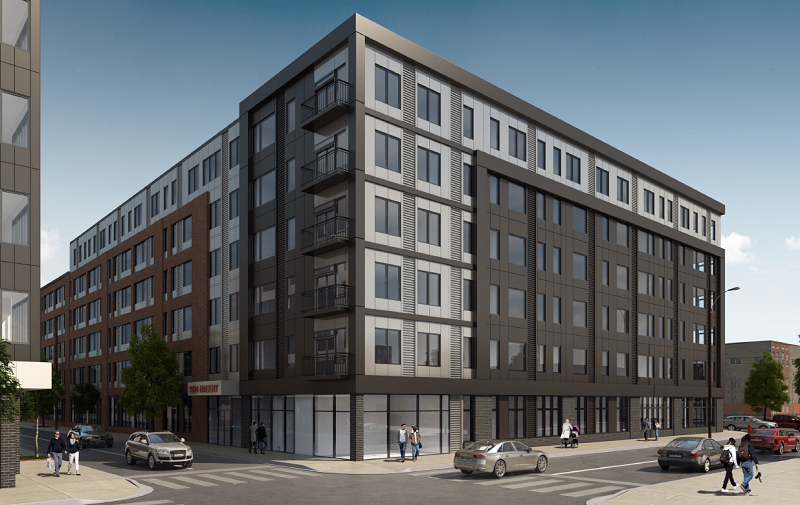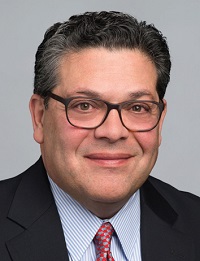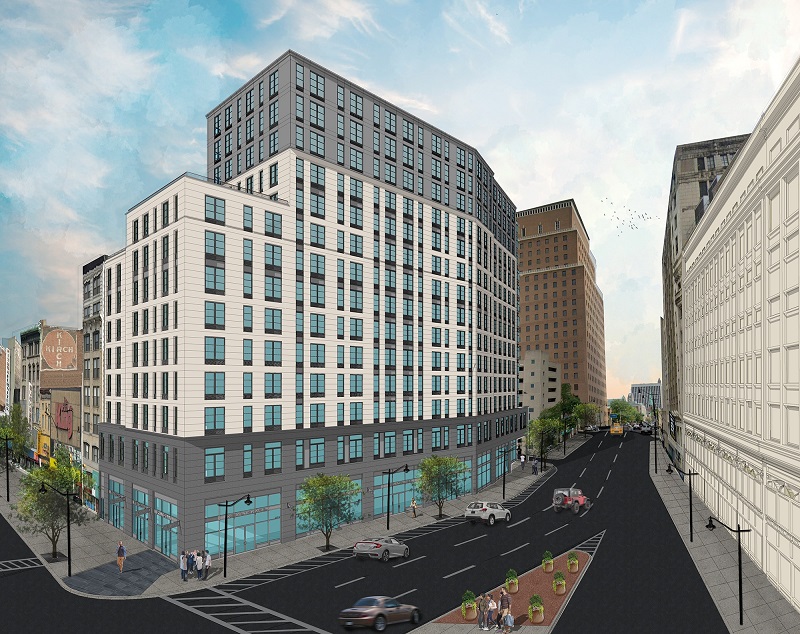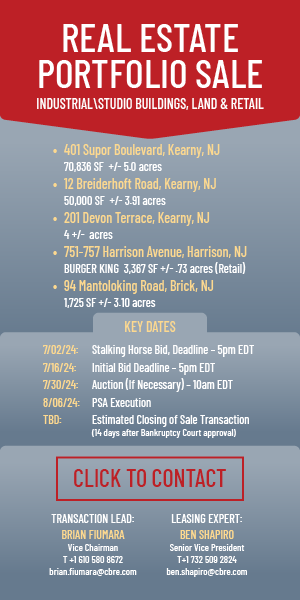RBH Group is moving ahead with the sweeping redevelopment in downtown Newark known as the Four Corners Millennium project, which will benefit from the federal Opportunity Zone program. — Courtesy: RBH Group
By Joshua Burd
The COVID-19 pandemic has threatened to stall many development projects nationwide, including those under the federal Opportunity Zone program, but experts say those investments could gain new momentum after a series of recent steps by regulators.
Developers and attorneys say the program, which provides tax benefits to those who invest in certain distressed areas, received a boost in early June when the IRS relaxed the deadlines for both investing in an Opportunity Zone fund and putting those dollars to work. The additional breathing room could result in stronger projects by developers, experts say, while also providing them with an infusion of new cash later this year.

“While it went totally quiet, understandably, during this shelter-in-place period, it’s starting to awaken a little bit, so folks going through their tax planning may be in need of investments,” said Ron Beit, the founding partner and CEO of RBH Group in Newark. “And I would say that, while the volume has certainly slowed because of COVID, it’s now picking up again, and I think through the end of the year you’re going to see it continue to pick up.”
That makes Beit all the more optimistic as his firm continues to raise a so-called qualified opportunity fund, which launched last summer with a $40 million investment. RBH is now working in Opportunity Zones across the country, including Newark, where it’s planning the seven-building, mixed-use Four Corners Millennium project in one of the downtown’s historic neighborhoods.
The federal program has attracted other developers and investment managers since its launch in late 2017, aiming to steer long-term investment to distressed and low-income communities. Created as part of the Tax Cuts and Jobs Act, the vehicle allows investors to defer and potentially reduce taxes on capital gains from an unrelated asset sale, provided they redeploy those funds into one of nearly 9,000 census tracts nationwide, including 169 in New Jersey.

Buzz around the program ebbed and flowed as the IRS issued piecemeal regulations over two years, insiders say. But once the guidelines were finalized late last year, “there was a lot of anticipation in the Opportunity Zone world that you would see an uptick in activity,” said Matthew Schiller, a partner with Murphy Schiller & Wilkes LLP in Newark.
That changed suddenly in March amid the public health and economic crisis tied to the coronavirus outbreak in the U.S., largely wiping out discussions about the program and the tax benefits that come with it.
“In my mind, it almost wasn’t the time and the place to be dealing with that,” said Schiller, who leads MSW’s leasing, Opportunity Zone and distressed real estate practice groups. “But you still did have concurrently a number of projects that were located in Opportunity Zones that were getting developed or in their approval stages, as well as a number of clients who had Opportunity Zone dollars that they needed to spend or invest in early to mid-2020.
“So you still had to be very mindful of the time sensitivities involved,” he added, citing the 180-day period in which investors seeking to defer capital gains taxes must redirect that money into a qualified opportunity fund. That meant that clients who had sold eligible assets in late 2019 were on the clock to find an Opportunity Zone investment in March, April and May.
The IRS helped ease some of those concerns in April, when it announced that any taxpayer whose 180 days fell on or after April 1 now had until July 15 to make a decision. In a more wide-ranging notice in early June, the agency pushed that deadline to Dec. 31, while extending several other requirements for existing funds.
For instance, the guidance provided relief for investment funds that had deployed their capital but were still early in the development process. While Opportunity Zone funds typically have 30 months to complete a “substantial improvement” of the property, the IRS said the period between April 1 and Dec. 31 will not count toward that requirement, giving developers additional time amid the economic slowdown.

“That has become extremely important, because we’ve had deals that were put on hold due to the uncertainty of COVID-19,” said Bonnie Diaz, a tax planning and advisory attorney with Chiesa Shahinian & Giantomasi PC in West Orange. “So these extensions at the Opportunity Zone fund level and the business level have been very crucial.”
Insiders note that the guidance also waived penalties for funds that did not deploy 90 percent of their holdings within six months, as required by the law, if their deadline to do so fell between April 1 and Dec. 31. Schiller said that benefited clients that were pursuing investments “that may not have been the perfect deal … especially in the current market,” but were under pressure to put their funds to work.
“It took the pressure off,” he said. “So they were able to go and pass on certain deals that they may have otherwise proceeded with, in order to spend more time and let the market sift itself out a little bit and find better opportunities.”
The amended timelines may also help draw new investors to the program. Beit noted that individuals with 2019 capital gains may have balked at investing in a qualified opportunity fund when the pandemic struck the U.S. in March. But he said the added breathing room — and a later tax filing deadline — may have given them time to fully understand the benefits.
“I think that captured a large swath of investors that now could still be potential OZ investors, whereas had they not gotten the extension in that timeframe, they would be foreclosed from becoming investors,” Beit said. “I think that’s huge because there were a lot of gains coming out of 2019 that you don’t want to lose in terms of being able to get those invested in these projects.”


Still, the pandemic’s impact may loom large for investors going forward. Anthony Rinaldi, the managing principal of Summit-based Saxum Real Estate, said he believes entrepreneurs will continue to sell businesses and realize capital gains that they will need to invest, which will bode well for Opportunity Zone fund managers. But he said that other sources of capital gains, such as the stock market, face an uncertain future after more than three months of dramatic swings tied to the coronavirus.
“A lot of the investors that were looking at Opportunity Zone investments to harvest gains that they were finding in the equities market probably hit a pause,” said Rinaldi, whose firm has Opportunity Zone investments in Philadelphia, Austin and other U.S. cities. “And I think that they’ve been in a challenging space … There’s obviously an enormous amount of volatility in the market, which creates uncertainty, especially for retail investors, so I think, if anything, there’s now trepidation about what (they) should do.”
Investors may in fact be conflicted, he added. Those that stayed in the market may now be waiting for what they feel is a better opportunity to exit, while others see the volatility, economic uncertainty and the prospect of lower interest rates as a reason to move into real estate sooner rather than later.
Also unknown is whether existing real estate investors will continue to look at Opportunity Zones as a primary vehicle for their gains. Attorneys with Chiesa Shahinian & Giantomasi say that, even pre-COVID, many savvy real estate players were passing on Opportunity Zones and instead opting for the decades-old option known as the 1031 exchange. Under the latter, a seller of a property can defer capital gains taxes by acquiring a similar asset within 180 days.

“You’ve always had this tax deferral mechanism in real estate with 1031,” said Frank Giantomasi, a member of CSG’s real estate, development and land use group. That has not been the case for investors who sold stock, businesses and other assets, he said, so it’s become clear that “the utilization of the (qualified Opportunity Zone) is much more driven by a non-real estate trigger.”
Diaz, a counsel with CSG, also noted that Opportunity Zone investments must be held for 10 years to realize the full tax savings, whereas a 1031 exchange carries no such requirement. What’s more, the law requires Opportunity Zone investors to pay taxes on their deferred capital gains in 2026, even while their money is still in the fund.
“They’re just a little more certain and protective in terms of the tax benefits,” Diaz said. “We’ve seen significant QOZ activity — that is not to be underestimated — but I think 1031s are alive and well.”
Time will tell how investors from other industries view the Opportunity Zone program in the wake of the pandemic. But Beit said the relief from the IRS could go a long way, especially given that the program’s guidelines were not complete until late last year.
“You’re talking about a couple of months before COVID hit,” he said. “It’s definitely extremely helpful that you have these rules and regulations in place now and there is definition around this program. And I think once we get through this, it’s just going to be more and more accepted by retail investors, by the high net worth individuals — and I think it’s really going to start to gain traction.”
Developers, state officials face dual task with Opportunity Zone projects










